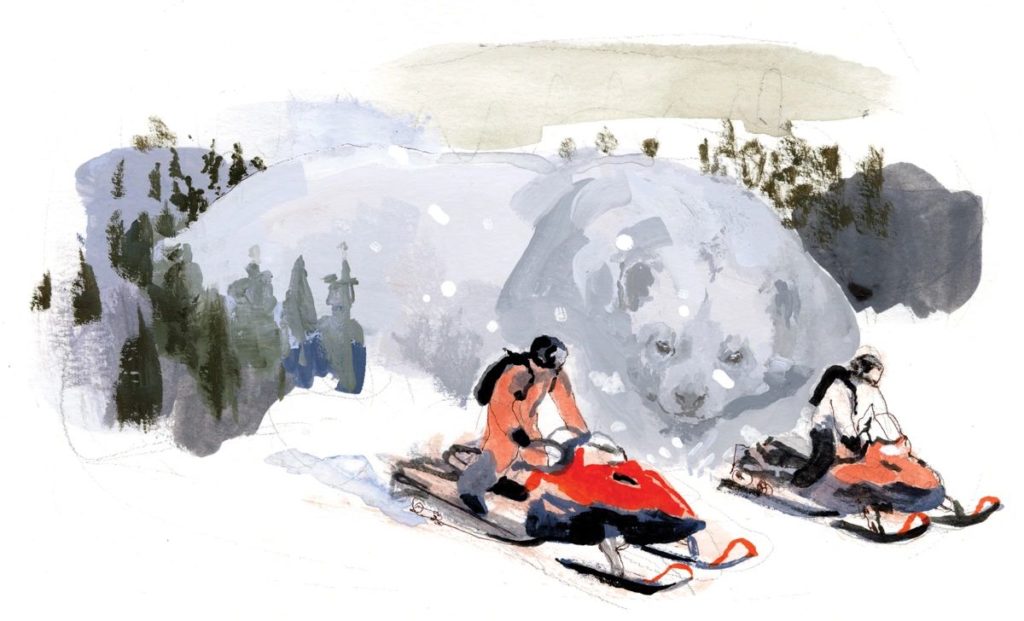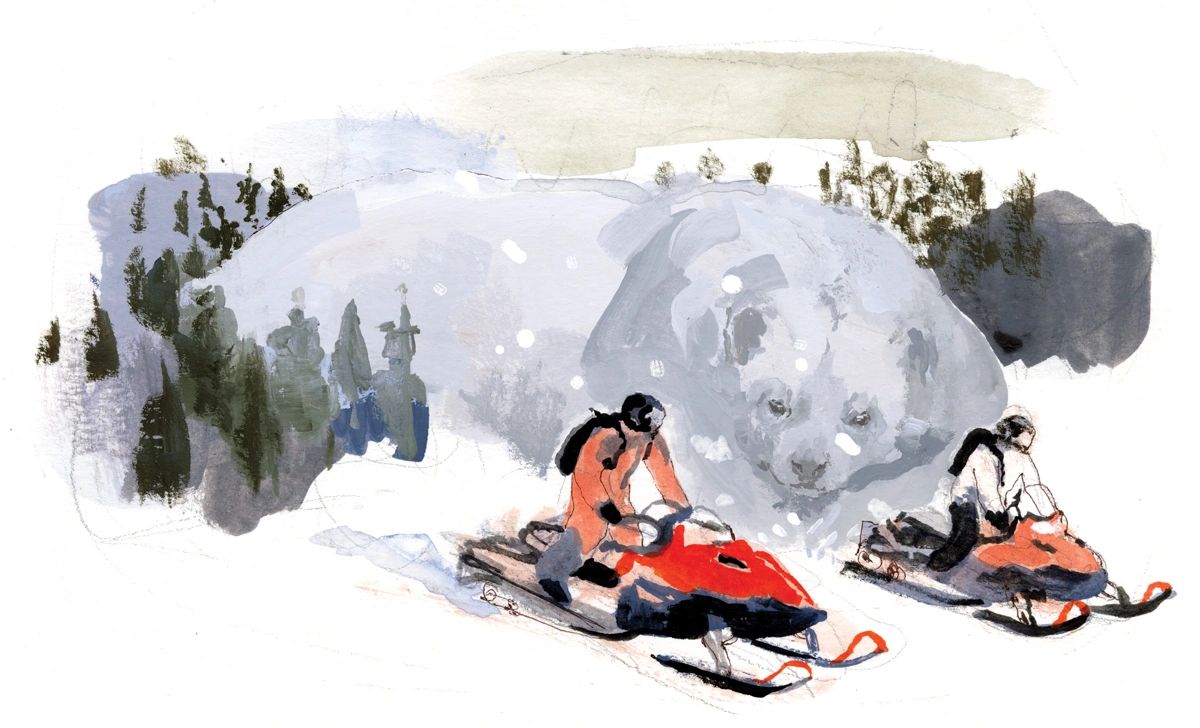As snowmobilers fight to preserve their pastime, scientists worry about the future of the species.
By Helen SantoroHigh Country News, March 16, 2020

Just outside the tiny town of McCall, Idaho, in the sprawling Payette National Forest, Sandra Mitchell drove her snowmobile across a snowy pass. With the loud whine of the machine’s engine ripping through the chilly winter air, she rode between rows of fern, pine and spruce. Soon, the forest opened up to reveal West Mountain with its inviting slopes and sparse clusters of trees. Setting her sights on the summit, she held down the throttle and pointed the nose of her snowmobile upward, a fan of powdery snow spraying out behind her.
At the peak, Mitchell glided to a stop, turned off the engine and gazed out over the silent snow. “You get to see nature dressed in white,” she said. “It’s breathtaking.”
That was just the first of many times that Mitchell rode up West Mountain. Today, around 27 years later, she is director of public lands for the Idaho State Snowmobile Association. In her many years of snowmobiling, she has seen a lot of wildlife: a male moose with a rack of antlers, wolf tracks in the snow. But neither she nor any of her snowmobiler friends has ever seen the animal whose tenuous status could lead to the closure of backcountry areas to recreationists like herself: the elusive wolverine.
Wolverines require a lot of land and snow in order to survive, making places like the Payette National Forest in west-central Idaho a perfect home. But this forest is also a hub for winter sports, drawing backcountry enthusiasts from across the nation. In 2007, however, a team of Forest Service employees proposed closing approximately 15,000 acres — less than 1% of the entire forest — to snowmobilers, partly to protect the wolverine. When Mitchell heard this, she balked. “It was shocking when we saw the proposal,” she said. The Idaho State Snowmobile Association claimed that it wasn’t based on sound science. “We’ll do what the science tells us,” she said, “but once the land is closed, it’s always closed. We need to work for other management options.”
In 2010, Mitchell and her team joined forces with eight other groups, including the Idaho Department of Fish and Game and the Sawtooth National Forest in central Idaho, in a collaborative effort to study how backcountry sports, including snowmobiles and backcountry skiing, impact wolverines.
But instead of generating a clear answer on how to balance recreation and wildlife, the science may have simply bolstered past convictions. The research — which was published in February 2019 and concluded that winter recreation displaces wolverines — has fueled an ongoing lawsuit regarding a proposed closure in the Sawtooth National Forest. “People are interpreting the research based on their own agendas,” said Kimberly Heinemeyer, a lead scientist at the Round River Conservation Studies, the ecological research and education nonprofit that spearheaded the study.
Now, snowmobilers like Mitchell are responding by suing the U.S. Forest Service, hoping to preserve one of their most cherished pastimes. Meanwhile, researchers worry that if the Forest Service doesn’t take action soon to protect wolverine habitat, the animal may disappear from the Lower 48.
FOR IDAHOANS LIKE MITCHELL, snowmobiling is woven into the cultural fabric of the state. In 1971, a group of nine snowmobilers rode into the woods near Pine, Idaho, one weekend and returned with the idea for the Idaho State Snowmobile Association. Around 20 years later, Mitchell became an integral part of the community and has since helped welcome thousands of new members. Today, snowmobiling generates millions of dollars within the state of Idaho. During the 2015-2016 winter season, snowmobile owners spent close to $200 million in lodging, food, equipment and more, and supported more than 4,000 retail and other jobs, according to a study by Boise State University.
Still, conservationists like the Idaho Conservation League’s Brad Smith believe that snowmobilers need to be more conscious of where they ride when they enter areas where sensitive species, like wolverines, are known to roam.
Wolverines are solitary animals that live in remote, cold places like Idaho, Montana and Alaska. Males can weigh up to 40 pounds — stocky creatures, with long, coarse fur, sharp claws and spectacular strength. By nature, they have very low-density populations with home ranges of up to 600 square miles. They’ve been known to travel up to 15 miles a day in search of food, which explains their scientific name, Gulo gulo, from the Latin word for “glutton.” Between February and May, in order to den and give birth, female wolverines require deep snow, which keeps their offspring safe from predators and buffers them from frigid winter temperatures. After a long history of fur trapping — a practice that is now banned in most states, including Idaho — there are only an estimated 250 to 300 wolverines left in the Lower 48. Today, wolverines have been reported in 77% of Idaho’s counties — most, if not all, of their in-state historic habitat — which includes snowy, mountainous areas where Mitchell and thousands of others snowmobile.
Today, wolverines have been reported in 77% of Idaho’s counties — most, if not all, of their in-state historic habitat — which includes snowy, mountainous areas where Mitchell and thousands of others snowmobile.
This interaction between winter recreationists and wolverines may harm the species, according to the study in the journal Ecosphere. Over the span of six winters, researchers investigated the responses of GPS-tagged wolverines in Idaho, Wyoming and Montana to snowmobilers and backcountry skiers. They found that wolverines avoided areas used by recreationists, with females being particularly sensitive to backcountry activity. Bit by bit, they were losing their habitat.
Reactions to the research have been mixed. Hilary Eisan, the policy director for the nonprofit Winter Wildlands Alliance, which represents backcountry skiers and outdoor recreation on public lands, argues that the study provides clear evidence that winter sports threaten wolverine habitat. Mitchell, on the other hand, claims the study only shows the need for more studies. “Overall, we were disappointed that there were not more conclusive results,” she said. “Wolverines move all the time, so them changing their habitat due to snowmobiles is not necessarily conclusive.” …Continue reading here.
Helen Santoro is an HCN fellow based in Gunnison, Colorado, who covers science and wildlife. She enjoys backcountry skiing and, when she has the time, camping in the frigid winter temperatures. This story was originally published by High Country News (hcn.org) on March 16, 2020

